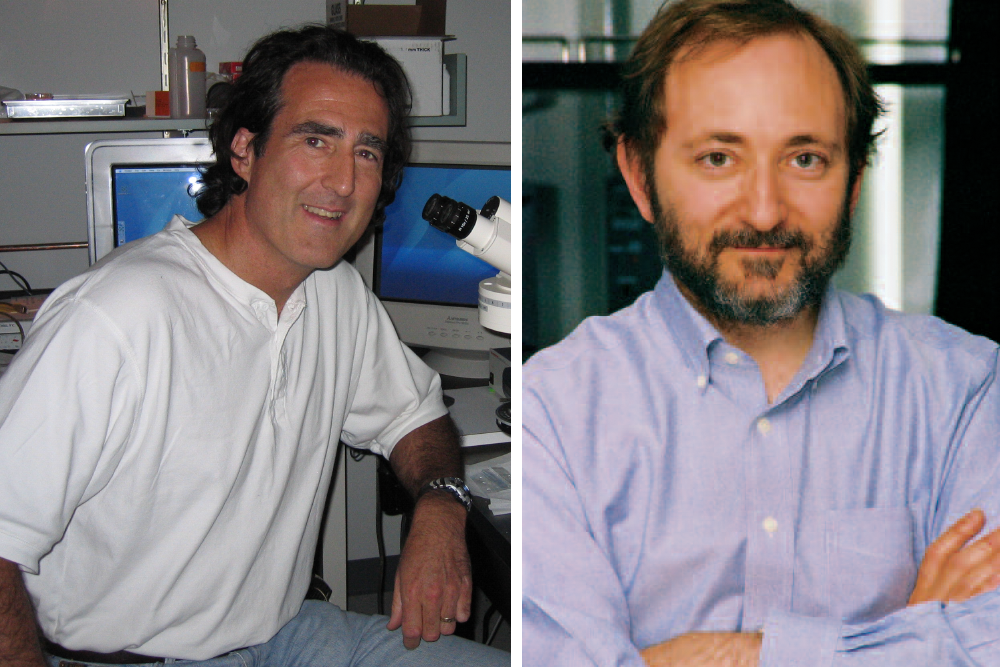- GU Home
- Paul Ehrlich Foundation
- Main Prize
- Preisträger 2006
Prize Winners of the Paul Ehrlich and Ludwig Darmstaedter Prize 2006


RNA Interference: Dicing and Slicing for the Sake of Healthy Cells
Importance of RNA interference
The DNA of any animal and plant cell contains thousands of genes. The cell uses various protective mechanisms to ensure that only those genes which are needed at any given time are translated into proteins. These mechanisms effectively regulate which genes are transcribed into messenger RNA which serves as a blueprint for protein synthesis by ribosomes, the cellular protein factories. However, not only endogenous genes have to be silenced, depending on their development level and the cell function. It is even more important that the cell should intercept and inactivate harmful genes, for example the genes of pathogenic organisms. To be able to do this, the cell has developed – in the course of evolution – highly effective security systems, including RNA interference discovered in 1998 by Craig Mello and Andrew Fire. Almost all plant and animal cells use this protective mechanism to destroy the RNA transcripts of potentially dangerous genes before the latter can be translated into proteins. With the help of RNA interference, the cell also regulates the activity of normal genes in the course of growth and development, because the genes active in a muscle cell are different, for example, from those in a nerve cell.
How does RNA interference work?
In RNA interference, the cell inhibits gene expression by forming double-stranded RNA molecules. Interference arises when an enzyme called "dicer" cuts longer double-stranded RNA molecules – viral RNA molecules, regulatory RNA sequences or synthetic RNAs introduced into the cell from outside – into fragments of a standard length (21 to 23 base pairs). All of these RNA pieces are subsequently cleft into their two single strands. One of them then combines with proteins to form the so-called "RNA-inducing silencing complex" (RISC). This complex intercepts messenger RNAs with complementary sections. If their sequence is a relatively perfect match with the original, the captured messenger RNA molecule is sliced in the middle by an RISC complex enzyme called "slicer" and rendered inoperable. As a result, the protein coded by this messenger RNA can no longer be formed. If the intercepted messenger RNA is only a partial match with the sequence of the RISC-bound siRNA, RISC simply retains the messenger RNA. Because of this, the ribosomes are held up by the messenger RNA in protein synthesis and also fail to form a functioning protein. Depending on the siRNA, therefore, the protein synthesis of certain genes can be completely shut off. This also applies to siRNA introduced into the cell from outside. "And that is where the great potential of RNA interference lies in its medical application", explains Dr. Rino Rappuoli, Institute for Immunological Research in Siena, Italy, and Member of the Paul Ehrlich Foundation's Scientific Council. "The point is that, through the synthesis of certain RNA double-stranded chains, you can determine precisely which target messenger RNA is to be destroyed."
Therapeutic potential
Through the introduction of defined siRNA molecules into human cell cultures (a technique pioneered by Dr. Thomas Tuschl's group, then at the Max Planck Insitute in Gottingen), thousands of research teams have succeeded in carrying out genetic interference experiments. These experiments have shown feasibility (at least in culture) of inhibiting the spread of viruses, including those responsible for aids, infantile paralysis and hepatitis C, at least temporarily, by stopping the production of viral proteins indispensable for the reproduction of pathogenic organisms. But the road to the therapeutic use of RNA interference on human beings is still long. The reason is that while the inhibiting effect of siRNAs spreads throughout the entire organism in the case of the roundworm Caenorhabditis elegans and in plants, there are local limits to this effect in mammals, including human beings. Just how siRNA can be transported to defined targets is the object of intensive research.
CONTACT
Office Paul Ehrlich Foundation:
Friends of the Goethe University Frankfurt
Goethe-Universität Frankfurt
Campus Westend, PA-Gebäude
Theodor-W.-Adorno-Platz 1
60629 Frankfurt am Main
www.vff.uni-frankfurt.de
Managing Directors
Nike von Wersebe
Tel: 069 / 798 12234
Fax: 069 / 798 763 12234
wersebe@vff.uni-frankfurt.de
Julia Lange
Tel: 069 / 798 12452
Fax: 069 / 798 763 12452
E-Mail: lange@vff.uni-frankfurt.de
Adviser for Members & Foundations
Tina Faber
Tel: 069 / 798 17237
Fax: 069 / 798 763 17237
faber@vff.uni-frankfurt.de
Marketing
Constanze von Plato
Tel: 069 / 798 17237
Fax: 069 / 798 763 17237
vonplato@vff.uni-frankfurt.de
Science Communication
Joachim Pietzsch
Tel: 069 36007188
j.pietzsch@wissenswort.com
Bank Account
Paul Ehrlich-Stiftung
Deutsche Bank AG
IBAN: DE38500700100700083900
BIC: DEUTDEFFXXX
Donations are tax deductible.
- Studying at Goethe University
- International applicants
- Faculties
- Overview of study programmes
- Programme for refugees
- GRADE
- Goethe Business School (continuing education)
- Research at Goethe University
- Scientific news
- Goethe Welcome Center (for international researchers)
- Collaborative research projects
- Individual research
- Visiting fellowships
- Endowed chairs
- About the University
- News-in-brief
- University administration
- Campus locations
- Campus life
- University archives (German)
- Rhine-Main-Universities








